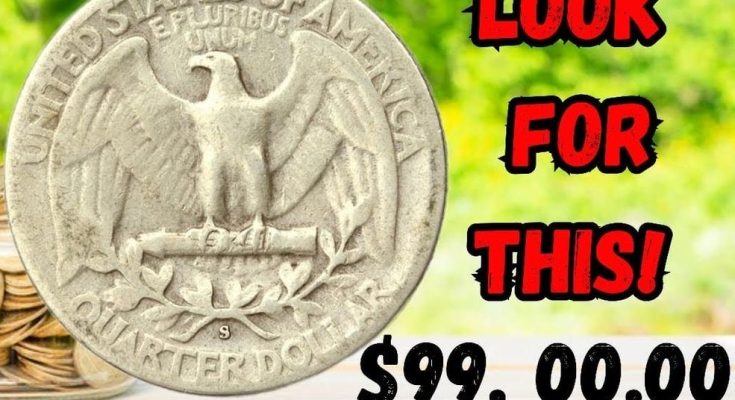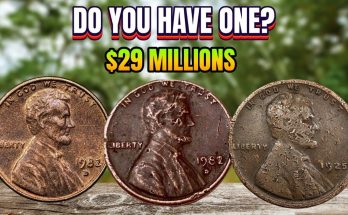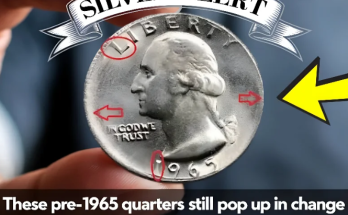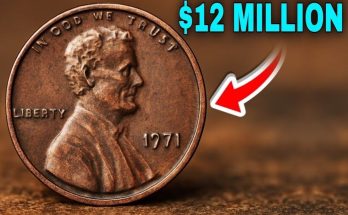Most people don’t give much thought to the coins that pass through their hands every day. Quarters are especially common — we use them for vending machines, parking meters, and laundry without even a second glance. But what if one of those quarters in your pocket could actually be worth thousands, or even tens of thousands of dollars? Hidden among ordinary change are rare Washington quarters that collectors will pay a small fortune to own. The coin in this image reminds us that some of the most valuable treasures are the ones hiding in plain sight. Let’s uncover the secrets of two special Washington quarters that might be sitting in your loose change right now.
The Washington quarter was first minted in 1932, originally created to celebrate the 200th anniversary of George Washington’s birth. Since then, billions of these coins have been produced in different designs and compositions. But certain rare versions — due to minting errors, limited runs, or unique metal compositions — have become extremely valuable to collectors. These rare coins, often referred to as “hidden gems,” are highly sought after because of their historical significance and scarcity.
The quarter shown here features the classic Washington eagle reverse design used from 1932 until 1998. The “S” mintmark at the bottom indicates it was minted in San Francisco, one of the key clues for collectors. Coins from the San Francisco Mint were often struck in smaller quantities, especially during the early years of the Washington quarter series. Finding one of these in good condition today is already special — but if you happen to come across one of the rare varieties, you might be looking at a coin worth thousands of dollars.
Hidden Gem #1: The 1932-D and 1932-S Washington Quarters
Among the most valuable quarters in circulation are the 1932-D and 1932-S Washington quarters. These were the first-year issues of the series and were minted in very low numbers. Only about 436,000 of the 1932-D and 408,000 of the 1932-S were ever produced. To put that in perspective, modern quarters are minted by the hundreds of millions each year! Because of their rarity and historical importance, these two coins are considered the “holy grails” of the Washington quarter series.
If you find a 1932 quarter with a small “D” (for Denver) or “S” (for San Francisco) mintmark on the back, near the base of the eagle, it could be worth a lot of money. Even a well-circulated example can bring several hundred dollars, while coins in excellent or uncirculated condition can sell for thousands. In fact, pristine examples have fetched over $25,000 at auction! Imagine finding that kind of treasure in your spare change jar.
Hidden Gem #2: The 1965–1967 Silver Error Quarters
Another hidden gem to watch for comes from the mid-1960s. In 1965, the U.S. Mint stopped using silver to make quarters and switched to a copper-nickel composition due to rising silver prices. However, a small number of 1965 quarters were accidentally struck on leftover 90% silver planchets meant for the 1964 issue. These “silver error” quarters are extremely rare, and collectors will pay a premium to own one.
The easiest way to identify one of these rare errors is by checking the coin’s edge. Regular quarters minted after 1965 have a visible copper-colored stripe along the rim, while the silver versions have a solid silver edge. A 1965 quarter with no copper line — and weighing slightly more (around 6.25 grams instead of 5.67 grams) — could be one of these valuable minting mistakes. Some of these coins have sold for $7,000 to $10,000 or more, depending on condition and certification.
What Makes These Coins So Valuable?
The value of a coin depends on three main factors: rarity, condition, and demand. A rare coin that was produced in small numbers or has a unique error automatically attracts collector interest. If the coin is in excellent condition — showing little wear or damage — its value increases dramatically. Finally, demand plays a huge role. Washington quarters are one of the most popular U.S. coin series to collect, meaning there’s a large community of buyers willing to pay top dollar for special finds.
Mint marks are also crucial in determining value. Washington quarters were minted at three main locations: Philadelphia (no mint mark), Denver (D), and San Francisco (S). San Francisco coins, especially from the 1930s and early 1940s, often carry higher value because fewer were made. That’s why collectors are always on the lookout for that small “S” or “D” under the eagle on the reverse side of older quarters.
How to Check Your Coins
Before you rush to spend your spare change, take a few minutes to inspect your quarters. Start by sorting them by date. Any quarter from 1964 or earlier is made of 90% silver and automatically worth more than face value — usually several dollars each depending on silver prices. Then, look closely at coins from 1932, 1965, and other transitional years for mint marks and potential errors. A magnifying glass and a good light can make a big difference when examining small details.
If you think you’ve found something special, don’t clean the coin — that can actually lower its value. Instead, place it carefully in a protective holder and have it evaluated by a professional coin dealer or grading service such as PCGS or NGC. They can verify whether your coin is genuine and provide an official grade, which is essential if you ever plan to sell it.
Final Thoughts
The next time you get change from a store, remember that it might be more valuable than you think. The Washington quarters in your pocket could hold hidden gems waiting to be discovered. Whether it’s the rare 1932-D or 1932-S quarter, or the elusive 1965 silver error, these coins prove that even small change can lead to big rewards. So grab a magnifying glass, start checking your quarters, and who knows? You might just uncover a coin worth thousands — maybe even the $99,000 one shown here!



